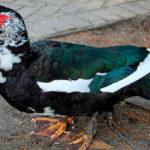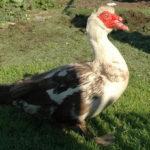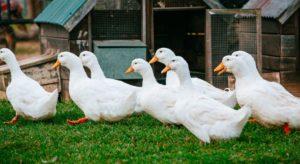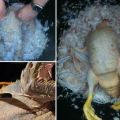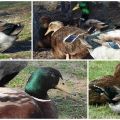Description of the breed of mute ducks and breeding at home for beginners
Mute ducks are considered by farmers to be one of the most successful breeds for breeding at home. The bird is unpretentious, does not require special conditions for keeping. The meat is tasty and does not contain much fat. And knowing some of the features of care will save beginners from mistakes and make the growing process simple and profitable. The descendants of the mallard are fertile and have not lost their hatching instinct.
History of the origin of the breed
The oldest breed in the world dates back to the time of the Aztecs. According to one version, ducks, which are also called musky, were bred in the Muisca Indian tribe. Other researchers believe that the birds got this name due to the aroma that gives off fat when heated. And the third nickname - whisperers - was given to ducks for their ability to make quiet sounds instead of loud quacking.
From South America to the African continent and to the countries of Asia, mute ducks came along with slaves returning to their homeland. Gradually, domesticated mallards spread throughout the world.
At first, poultry farmers were reluctant to breed the musky subspecies. Farmers were repelled by the unpleasant appearance of birds. But over time, breeders appreciated the high productivity of the ducks. Breeders are often used by breeders to breed new breeds.
Description and characteristics of mute ducks
Shipunov can be easily recognized by their large, elongated body with widely spaced legs. Red growths are located around the flattened beak of the Indo-duck.
In the future, the birds get better due to the accumulation of fat. Indo-duck meat is highly prized. The products do not have an unpleasant odor. The egg production of mute ducks is average. Females produce up to 100 eggs annually, each weighing about 90 grams.
Pros and cons
Mute duck farmers are attracted by their peaceful disposition and quiet demeanor. The birds also have some disadvantages.
The presence of negative qualities does not interfere with the cultivation of mute ducks. The birds have more positive traits.
Requirements for maintenance and care
When breeding mute ducks at home, advice from experienced poultry breeders will be useful for beginners:
- The birds are kept in spacious rooms. Mute mutees show aggression in the cramped duck. No more than 3 individuals can live on a square meter.
- Ducks are afraid of drafts and sudden changes in air temperature.
- The house is recommended to be kept clean and cleaned regularly.
- The floor is covered with straw or sprinkled with dry shavings.
- Perches are installed at a height of 10-15 centimeters from ground level.
- Good lighting for 14 hours will increase egg production.
A pen for walking birds is also arranged near the poultry house. It is useful for ducks to be outdoors from morning to late evening.

The period of sexual activity of drakes begins in April and lasts until July. 1 male fertilizes 2 or 3 ducks. Layers from 6 months are kept in a separate room.
Nutrition
Mute ducks are unpretentious in food, but they are responsible for compiling a diet for waterfowl.
| Product name | Characteristic |
| Cereals | Barley, wheat and ground corn |
| Greenery | Dandelions, clover, freshly cut meadow grass |
| Vegetables | Grated pumpkin and carrots, boiled potato puree |
| Nutritional Supplements | Fish oil, bran, bone meal, salt, yeast, shells |
Experienced farmers feed the ducks with grain in 2 doses. Half of the daily amount is given unprocessed, vegetables and herbs are added to the rest.
If there is a reservoir, mute beetles are transferred to grazing from 10 am. And birds receive a mixture of cereals with other ingredients once a day. Overeating is bad for poultry, as is underfeeding.
Breeding
Mute ducks reach the age of sexual activity by 9 months. Poultry usually rush at night or at dawn. For this reason, waterfowl are not sent too early to graze. The number of eggs in the nest is carefully controlled. The laying hen does not start incubating until 15 pieces are typed. Sometimes farmers lay eggs for the female, which the duck refused to incubate with the lost maternal instinct.
The female needs a little more than a month to hatch. All this time, the ducks may not get up. The birds turn their eggs over and spray them with water from their beaks.
When breeding mutees are not crossed with individuals from the same offspring. Closely related relationships lead to pathologies and degeneration.

Possible diseases
Ducks have high immunity. But some diseases are inherent in this breed:
- Two-week-old chicks occasionally develop viral hepatitis. Sick ducklings become lethargic and lose their appetite. For treatment, a course of antibiotics is prescribed.
- With poor maintenance, birds develop parasitism. In this case, the entire room must be disinfected. Pathology is fought with the help of medicines.
- Salmonellosis is manifested by convulsions and conjunctivitis. Household sanitation and antibiotics can correct the problem.
- Green, frequent stools, refusal to eat mean emeriosis. In this case, veterinarians prescribe a complex treatment.
- One of the worst diseases is cholera, which can kill an entire joint. The characteristic symptoms are swollen paws and high fever. The meat of such birds is no longer suitable for food. Duck carcasses are burned.
In order to prevent the development of dangerous pathologies, compulsory vaccination of birds is carried out. Hygiene measures are of great importance.
Mute breeding is a profitable business. If you follow the simple rules for caring for the ducks, they quickly gain weight. Poultry meat is tender, tasty and without a specific smell. Additional income can be obtained from the sale of eggs.



